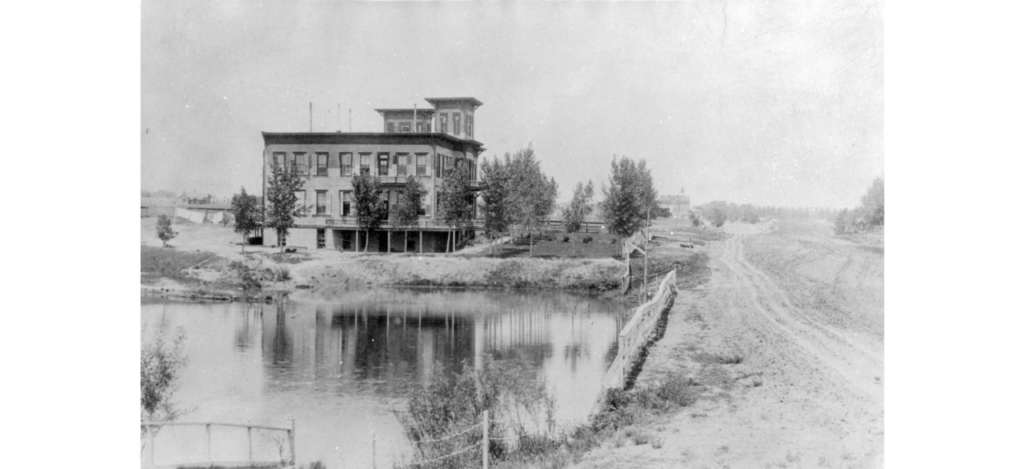By Rebecca A. Hunt
In the 1870s, Denver had a shortage of hospitals. The county ran the Arapahoe County Hospital to treat the poor who had serious illnesses such as smallpox, diphtheria, cholera and of course the ever-present tuberculosis.
The county hospital was at Speer Boulevard and 8th Avenue, at the present location of Denver Health. St. Vincent’s was a Catholic hospital that also treated the poor. It was first located in the red-light district at 19th Avenue and Market Street, which then became St. Joseph Hospital at East 18th Avenue and Humboldt Street in central Denver.

There were not any hospitals near northwest Denver. The Northside had its share of doctors, so those who were ill and wealthy could be treated in their own homes by their own doctors. Many other people depended on family members to nurse them through childbirth or illnesses, only calling a physician when absolutely necessary.
Residents of the working-class and immigrant neighborhoods of north Denver got help from midwives, family and, if things got too bad, a trip to the charity hospitals. The new town of Highland was hoping for its own hospital, even though some people saw them as dangerous, in fact calling them “pest houses.” Down at West 17th Avenue and Federal Boulevard, known simply as Boulevard, there was a two-story building that had originally been the Grandview Hotel.
When that failed, mostly because it was too far out from Denver, it briefly became a facility to treat those with mental and emotional problems. In 1874 the Episcopal Church brought in its newest bishop, John Franklin Spalding. The bishop and his wife, Lavinia, became the drivers of a movement to build an Episcopal hospital in Denver.
While he began to look for a location, she organized the Ladies’ Aide Society to make sure that the new hospital had enough supplies to be the best medical facility in Denver. They intended to be open to all, of whatever race or ethnicity, and to rich and poor alike. What they found was the old Grandview Hotel. There were some advantages to the site. It was on Boulevard, which was a good dirt road.
The small lake next door offered a ready supply of fresh, artesian, spring water. But there were a few problems as well. It was an hour-long ride from the center of Denver. In fact, the doctors frequently complained about having to drive, in the dead of night, through The Bottoms, which was Denver’s riverside slum.

Boulevard. Photo courtesy of The Denver Public Library Western History and Genealogy Digital
Photo Collection
The building also needed a lot of work. And it was in an area that did not yet have many residents. But it was inexpensive and available. St. Luke’s Hospital opened its doors on June 27, 1881. The first patients arrived soon after, but there were never enough to truly make ends meet. The women’s group and a steady group of supporters spent considerable time finding food, supplies and money.
After President James Garfield was assassinated, the country mourned and then got back to business. Many shops had made makeshift memorial bunting of black-andwhite cotton cloth. The ladies had donated materials, and their servants made bedding, surgical drapes and bandages from the fabric. One supporter even gave a cow so that the patients could have fresh milk.
The Ladies’ Aide Society members collected donated food to feed patients and sometimes staff. In October 1882, the women held their first St. Luke’s Gala Ball. It added $2,000 to the coffers and became an annual event. During the 10 years St. Luke’s was in northwest Denver, the hospital rarely had enough patients to make ends meet.
Eventually they negotiated contracts with the Rio Grande and Burlington railroads to treat worker injuries. This brought them closer to solvency. By 1891 it was clear to everyone running the hospital that it needed to be nearer to the population center. So, the board accepted two lots and purchased additional land at East 20th Avenue and Pearl Street in central Denver.
After the new St. Luke’s buildings opened in 1892, the old site on Boulevard stood empty. Beginning in 1892, the nearest hospital was St. Anthony Hospital near Sloan’s Lake.
Dr. Rebecca A. Hunt has been a Denver resident since 1985. She worked in museums and then taught Colorado, Denver and immigration history at the University of Colorado unitil she retired in 2022.

Be the first to comment